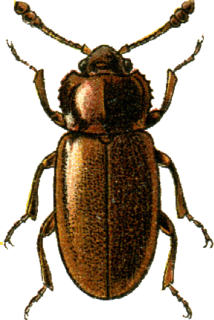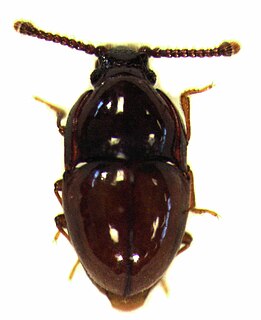Curelius is a genus of silken fungus beetles in the family Cryptophagidae. There are at least two described species in Curelius.

Atomariinae is a subfamily of silken fungus beetles in the family Cryptophagidae. There are about 8 genera and more than 170 described species in Atomariinae.

Cryptophaginae is a subfamily of silken fungus beetles in the family Cryptophagidae. There are about 11 genera and more than 180 described species in Cryptophaginae.

Henoticus is a genus of silken fungus beetles in the family Cryptophagidae. There are at least four described species in Henoticus.
Henotiderus is a genus of silken fungus beetles in the family Cryptophagidae. There are at least four described species in Henotiderus.
Pteryngium is a genus of silken fungus beetles in the family Cryptophagidae. There is one described species in Pteryngium, P. crenatum.
Telmatophilus is a genus of silken fungus beetles in the family Cryptophagidae. There are about seven described species in Telmatophilus.
Hirsutotriplax is a genus of pleasing fungus beetles in the family Erotylidae. There is one described species in Hirsutotriplax, H. mcclevei.
Salebius is a genus of silken fungus beetles in the family Cryptophagidae. There are at least four described species in Salebius.

Caenoscelis ferruginea is a species of silken fungus beetle in the family Cryptophagidae. It is found in Europe & Northern Asia and North America.

Caenoscelis is a genus of silken fungus beetles in the family Cryptophagidae. There are about 19 described species in Caenoscelis.

Atomaria is a genus of silken fungus beetles in the family Cryptophagidae. There are more than 160 described species in Atomaria.
Myrmedophila is a genus of silken fungus beetles in the family Cryptophagidae. There is one described species in Myrmedophila, M. americana.
Tisactia is a genus of silken fungus beetles in the family Cryptophagidae. There is one described species in Tisactia, T. subglabra.
Brevipogon is a genus of soft-bodied plant beetles in the family Artematopodidae. There is one described species in Brevipogon, B. confusus.
Micropsephodes lundgreni is a species of beetle in the family Anamorphidae. It is found in North America.
Micropsephodes is a genus of beetles in the family Anamorphidae. There are at least two described species in Micropsephodes.
Hadromychus is a genus of handsome fungus beetles in the family Endomychidae. There is one described species in Hadromychus, H. chandleri.







